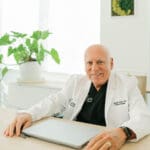How Slowing Cell Growth May Help Extend Healthy Lifespan
As a physician who works in longevity and regenerative medicine, I often have to explain a very counterintuitive idea:
The same biological systems that help us grow, repair, and stay strong when we are young can actually speed up aging when they stay switched on all the time in midlife and beyond.
At the center of this story is a protein complex called mTOR and a medication called rapamycin, along with a powerful repair peptide called Thymosin Beta 4, sometimes used in the form called TB500.
This overview is for education only and is not personal medical advice. Any use of these medications must be supervised by a qualified physician.
Meet mTOR
Your Body’s Growth Accelerator
mTOR stands for mechanistic target of rapamycin. You can think of it as your body’s main growth switch.
mTOR is very sensitive to your environment. It turns on when:
- You eat a protein rich meal
- Growth hormones and insulin like growth factor, also called IGF 1, are high
- Your cells sense plenty of amino acids and energy
When mTOR is active, it sends a clear message to your cells:
“Grow, divide, and build.”
That means:
- Increased protein production
- More cell growth and cell division
- More energy production in the mitochondria, which are the power plants of the cell
- A pause in autophagy, which is the internal cleanup and recycling system of the cell
In childhood, this strong growth signal is essential. It helps children grow taller, build bone and muscle, and heal from injuries. After surgery or trauma, mTOR activity is very important for wound healing and tissue repair.
The problem begins when the growth signal stays high all the time in adult life, often because of:
- Frequent eating and snacking
- High calorie and high protein intake
- Chronically elevated insulin and IGF 1
When mTOR stays chronically overactive, it pushes the body to keep growing and building when it should be focusing more on maintenance and repair. This is one of the core drivers of aging.
What Goes Wrong When Growth Never Slows
Protein Production Overload
When mTOR is overactive, your cells are constantly producing large amounts of new proteins. At first this seems good. Over time, however, the system becomes overwhelmed.
Imagine a factory running at full speed with no rest and very little quality control. Mistakes start to pile up. Faulty products move down the line faster than they can be fixed or thrown away.
In your cells, something similar happens. Protein making machinery works nonstop, which leads to:
- Misfolded proteins
- Damaged proteins
- Clumps of proteins that the cell cannot easily remove
These protein clumps and damaged proteins are a hallmark of many conditions related to aging, including memory decline, heart disease, and other chronic illnesses.
The Cleanup Crew Shuts Down
Autophagy literally means “self eating.” It is a healthy process where the cell:
- Identifies damaged parts
- Packages them into special compartments
- Breaks them down
- Recycles the usable components
You can picture autophagy as a professional cleaning crew inside every cell. They take out the trash and also salvage parts that can still be used.
High mTOR activity suppresses this cleaning crew. When mTOR is constantly on, autophagy is turned down or switched off. As a result:
- Waste products build up
- Damaged mitochondria continue to run poorly and release harmful reactive oxygen species
- Protein clumps accumulate
- The cell gradually becomes less efficient and more fragile
We know from many studies that autophagy tends to decline with age. We also know that increasing autophagy, through strategies like fasting, calorie reduction, or medications such as rapamycin, can extend lifespan in many different species.
“Zombie” Cells
Overactive mTOR also contributes to something called cellular senescence. Senescent cells are cells that have stopped dividing but refuse to die.
These cells:
- Do not perform their original job any longer
- Stay alive and active in a harmful way
- Secrete inflammatory molecules and enzymes that damage surrounding tissue
Because of this behavior, they are sometimes called “zombie cells.” They are like workers who no longer do useful work, will not retire, and actively harm the workplace.
As these senescent cells build up, they create chronic inflammation in tissues. Chronic inflammation is a major driver of aging, heart disease, cancer risk, and many degenerative conditions.
Stem Cell Exhaustion
Your tissues rely on stem cells, which are special cells that can replace damaged or worn out cells.
When mTOR is chronically high:
- Stem cells are pushed to divide too often
- They either burn out early or become senescent themselves
Over time this leads to poorer healing, slower recovery from injury, and a general loss of regenerative capacity. This is one reason we heal more slowly and lose tissue quality as we age.
Mitochondrial Stress
mTOR ramps up mitochondrial activity to produce more energy. Some increase in energy production is helpful, but chronic overdrive creates more reactive oxygen species, also called ROS.
In excess, ROS damage DNA, proteins, and cell membranes. This damage is a major contributor to the aging process.
The Evidence For mTOR Inhibition And Longer Life
This is not just a theory. When scientists lower mTOR activity in many different organisms, those organisms live longer and stay healthier.
In yeast, worms, flies, and multiple mouse strains, reduced mTOR activity extends lifespan. Rapamycin, a medication that inhibits mTOR, has been especially well studied.
In important mouse studies:
- Middle aged mice who received rapamycin lived longer and developed age related diseases later
- In one study, mice that were comparable in age to a 60 year old human received rapamycin for only three months
- After treatment stopped, these mice still lived much longer than untreated mice and had better health markers
The opposite is also true. When animals are engineered to have extra high mTOR activity, they show:
- Shorter lifespans
- More inflammation
- Faster organ damage
- Earlier onset of diseases associated with aging
This two way relationship strengthens the conclusion that mTOR is a central driver of the aging process.
Growth Hormone And IGF 1
The Same Story From A Different Angle
Human growth hormone, often abbreviated GH, and its partner IGF 1, are also part of this growth system. GH turns on pathways that activate mTOR. When GH levels are high for long periods, mTOR signaling is increased.
Across different species, the pattern is clear:
- High or continuously elevated GH and IGF 1 speeds aging
- Lower GH signaling slows aging and can lengthen lifespan
In certain strains of mice that naturally lack growth hormone or cannot respond to it, the mice live much longer than normal mice. The increase in life expectancy in these animals is very large, roughly comparable to adding several decades of healthy life in humans.
Laron Syndrome In Humans
Laron syndrome is a rare genetic condition where people have very little functional growth hormone receptor activity. As a result, they are quite short, often reaching a height of only about four feet.
However, they show remarkable protection from conditions associated with aging:
- Very low rates of cancer
- Very low rates of type 2 diabetes
- Better brain aging on imaging studies
- Much less plaque in the arteries compared with their relatives who share the same environment and diet
One of the key reasons is that these individuals have very low IGF 1 levels. This means their cells receive fewer growth signals, which appears to protect them over the long term.
What We Learn From Centenarians
People who reach one hundred years of age or more often show:
- Lower IGF 1 activity
- Better insulin sensitivity
Many of them carry genetic variations in the IGF 1 receptor that make it less active. In plain language, their growth signals run a little “cooler” for most of their lives, which seems to support longer lifespan.
A Clinical Nuance
When Growth Hormone Helps And When It Hurts
It is important to separate two very different situations.
- Chronic elevation of GH and IGF 1 over many years
- Short term or physiologic replacement therapy in people who are deficient
The first situation, chronic elevation, is what speeds aging and increases risks such as cancer. This is seen in conditions like acromegaly or in people who abuse GH for muscle building.
The second situation is very different. In someone with proven deficiency, carefully monitored GH in low, physiologic doses for a limited time can help with:
- Growth in children who lack GH
- Healing after certain injuries
- Correcting a true hormone deficiency
In a longevity practice, we may sometimes use short courses of GH or related therapies to assist with acute healing, while relying on long term mTOR modulation, usually with rapamycin, for overall longevity.
The key principle is this:
Avoid continuous, long term overactivation of growth pathways in midlife and beyond.
Rapamycin
From Island Soil To Longevity Medicine
Rapamycin was first discovered in soil from Easter Island, also called Rapa Nui, in the early nineteen seventies. It was initially studied as an antifungal compound. Researchers later found that it is a powerful immune suppressant, and it was approved to help prevent organ transplant rejection.
Only later did scientists discover that rapamycin works by inhibiting mTOR. That discovery opened the door to a new understanding of aging.
How Rapamycin Works At The Cellular Level
Inside the cell, rapamycin binds to a small helper protein called FKBP12. This pair then binds to a specific portion of the mTOR protein.
This binding partly blocks the ability of mTOR to form one of its main complexes, called mTORC1. mTORC1 is the complex that drives growth and suppresses autophagy.
Cells have two main mTOR complexes:
- mTORC1, which promotes growth, protein production, and suppression of autophagy
- mTORC2, which is more involved in metabolism, cell survival, and cell structure
At low to moderate intermittent doses, rapamycin mainly affects mTORC1. With very high or continuous dosing, it can also interfere with mTORC2, which can lead to problems such as insulin resistance.
This difference matters. For longevity purposes, we aim to inhibit mTORC1 in a periodic way, while minimizing unwanted effects on mTORC2.
What Happens When mTORC1 Is Calmed
When rapamycin reduces mTORC1 activity, several beneficial things happen:
- Autophagy is activated, so cellular cleanup and recycling improve
- Protein production slows to a healthier, more sustainable level
- Inflammation tends to decrease
- Cells become more resilient to stress
- Mitochondria are renewed as damaged ones are cleared away
The result is a shift from constant growth and expansion toward repair, maintenance, and quality control.
The PEARL Trial
First Large Human Longevity Study With Rapamycin
For many years, rapamycin’s longevity effects were shown mainly in animals. That began to change with the PEARL trial, which stands for Participatory Evaluation of Aging With Rapamycin For Longevity.
In this study, healthy adults took five milligrams of rapamycin once per week for one year.
Key findings:
- The regimen was generally well tolerated
- Side effects were mild and manageable
- Certain biological markers of aging improved modestly
This trial does not yet prove that rapamycin extends human lifespan. That would require many more years of follow up. It does suggest that once weekly low dose rapamycin can be used safely under supervision in carefully selected adults.
A Practical Rapamycin Approach
Typical Dosing And Why Weekly Use Makes Sense
In many longevity practices, including my own, a common protocol for appropriate candidates is:
- Start at three to five milligrams once per week
- If well tolerated, consider increasing to five to eight milligrams once per week
Always on the same day of the week and ideally at the same time. Some people prefer evening dosing so that any mild fatigue occurs during sleep.
Weekly dosing seems to work well because:
- It mainly inhibits mTORC1
- It allows mTORC2 to recover between doses
- It creates periodic windows of autophagy and cellular cleanup
- It avoids the deeper immune suppression seen with daily transplant doses
If side effects appear, we often increase the time between doses, for example every ten to fourteen days, rather than immediately cutting the dose. This can preserve many benefits while giving the body more time to clear the drug.
Safety, Monitoring, And Side Effects
Rapamycin is a prescription medication that must be supervised by a physician. Before starting, I typically order:
- A comprehensive metabolic panel to assess kidney and liver function
- Fasting glucose and hemoglobin A1c to assess blood sugar control
- A lipid panel to check cholesterol and triglycerides
- High sensitivity C reactive protein as a marker of inflammation
- A complete blood count to monitor blood cells
Some patients also check rapamycin blood levels, although we do not yet have a universally accepted target range for longevity.
Follow up testing often looks like this:
- At about six weeks after starting
- Then every three to four months during the first year
- Once stable, every six to twelve months
Common Side Effects
Most people tolerate low dose weekly rapamycin well. The most common issues are:
- Mouth sores that look like small canker sores in about ten to twenty percent of patients
- Mild fatigue for one or two days after dosing
- Mild increases in blood sugar or cholesterol in some individuals
Mouth sores can usually be managed with:
- Topical treatments
- Gentle oral care
- Occasional dosing adjustments
If blood sugar or lipids change, we usually address this with diet, exercise, possible addition of medications such as metformin or berberine, or adjustments to the rapamycin protocol.
At daily transplant doses, rapamycin clearly suppresses the immune system. With low dose weekly protocols, the available human data so far show minimal immune suppression and no clear increase in infections, though close monitoring remains essential.
Muscle Mass Concerns
Because mTOR is related to muscle growth, many people worry that rapamycin will cause muscle loss.
In practice, with once weekly low dose protocols, most patients who:
- Eat adequate protein
- Perform resistance training two or three times per week
are able to maintain or even increase muscle mass. Periodic dosing allows for windows of normal muscle building between doses.
We can support this by:
- Aiming for about 1.2 to 1.6 grams of protein per kilogram of body weight daily
- Doing regular strength training
- Placing higher protein meals two or three days after the rapamycin dose, when the effect is starting to fade
In some protocols, we also use Thymosin Beta 4 or TB500 to support tissue repair and muscle health, which I will explain shortly.
Who Should Not Use Rapamycin
Rapamycin is generally avoided or held in people with:
- Recent surgery, usually paused one to two weeks before and for about four to eight weeks after
- Pregnancy or breastfeeding
- Severe liver disease
- Active infections
- Known allergy to rapamycin
There are also important drug interactions, since rapamycin is processed by the liver enzyme called CYP3A4. Certain antibiotics, antifungals, herbs, and other drugs can increase or decrease rapamycin levels. This is one more reason this medication must be managed by a physician who reviews your full medication and supplement list.
Cancer, Surgery, And Special Situations
Rapamycin is interesting because it has both immune and anticancer effects.
- It is approved in certain cancers, such as specific kidney cancers and lymphomas
- It delays cancer onset in many animal models
- It reduces growth signals that many tumors rely on
For cancer survivors, rapamycin may offer the dual benefit of potential cancer protection and longevity effects, but it must always be coordinated with the oncologist. Timing around chemotherapy, radiation, and surgery is particularly important.
For surgery or acute injuries, mTOR is needed for rapid early healing. For this reason, we usually:
- Pause rapamycin before surgery
- Resume it only after the main phase of wound healing is complete
During this period, other tools that enhance healing without strongly activating mTOR chronically, such as Thymosin Beta 4 and TB500, may be considered.
Thymosin Beta 4 And TB500
Restoring Regeneration While Rapamycin Protects Longevity
Rapamycin solves one half of the problem. It calms chronic growth signaling, activates autophagy, and supports healthier aging.
However, many people do not want to trade longevity for sluggish healing or poor tissue repair. This is where Thymosin Beta 4 and its commonly used form TB500 come in.
Thymosin Beta 4 is a natural peptide found throughout the body, especially in platelets, immune cells, and tissues that are healing. TB500 is a synthetic peptide based on this natural molecule.
Thymosin Beta 4 and TB500 are known to:
- Promote tissue repair
- Encourage the growth of new blood vessels when needed
- Reduce inflammation
- Support stem cell activation and movement to sites of injury
Importantly, Thymosin Beta 4 appears to support autophagy and reduce inflammation through pathways that do not simply push mTOR into chronic overdrive. It modulates the PI3K and AKT pathways and increases a protective enzyme called heme oxygenase 1.
This makes it an elegant partner for rapamycin.
Why Rapamycin And Thymosin Beta 4 Work Well Together
The combination of rapamycin and Thymosin Beta 4 or TB500 is designed to solve a fundamental dilemma:
- Rapamycin improves longevity by slowing growth pathways
- Thymosin Beta 4 improves regeneration and healing
Together, they allow the body to cycle between:
- Periods focused on deep cellular cleanup
- Ongoing support for repair and regeneration
Rapamycin:
- Inhibits mTORC1
- Activates autophagy
- Reduces inflammation
Thymosin Beta 4 and TB500:
- Promote autophagy through different, complementary pathways
- Support stem cells and tissue repair
- Reduce inflammation, including through effects on the NLRP3 inflammasome
- Improve heart and blood vessel health in several animal models
Unlike growth hormone, which directly pushes mTOR higher and conflicts with rapamycin’s mechanism, Thymosin Beta 4 does not fight against rapamycin. Instead, it reinforces cellular cleanup and healthy repair.
A Sample Combined Protocol
There is no one size fits all protocol. Here is a simplified example that illustrates the rhythm many physicians aim for. All of this must be individualized in clinic.
Core components
- Rapamycin: for example five to seven milligrams once weekly by mouth
- Thymosin Beta 4 or TB500: for example two to five milligrams by subcutaneous injection twice weekly
Supportive agents
Many protocols add one or more of the following to support metabolism and reduce any tendency toward higher blood sugars with rapamycin:
- Metformin, for example 500 to 1000 milligrams daily
- Or a high absorption form of berberine, often around 500 milligrams twice daily
- Sometimes a combination at lower doses of each
Some patients also use DHEA, usually 25 to 50 milligrams daily, if appropriate based on hormone testing, to support energy, mood, and general vitality.
Example weekly rhythm
- One day of the week, such as Sunday
- Oral rapamycin dose
- This is the main mTORC1 inhibition day
- Oral rapamycin dose
- Midweek, for example Tuesday and Friday
- Thymosin Beta 4 or TB500 injections
- These support tissue repair and additional autophagy through alternative pathways
- Thymosin Beta 4 or TB500 injections
Daily, the person continues their metabolic support such as metformin or berberine, along with healthy nutrition, regular exercise, and good sleep.
In the first month or two, some practitioners use slightly higher initial doses of Thymosin Beta 4 or TB500 to build tissue levels, then transition to a steady maintenance dose.
Natural And Lifestyle mTOR Modulation
Not everyone is ready or a candidate for rapamycin. There are still meaningful ways to gently influence the same pathways.
- Intermittent fasting or time restricted eating can lower mTOR activity and activate autophagy
- Calorie reduction without malnutrition has strong longevity data in animals
- Certain plant compounds like green tea extract, curcumin, berberine, and fisetin have mild mTOR modulating and anti inflammatory effects
These approaches are weaker than rapamycin but can still provide benefits, especially when combined with:
- Strength training
- Cardio exercise
- Good sleep habits
- Stress reduction
I often describe them as “rapamycin light.” They work on similar themes but with much less potency.
Who This Combined Protocol May Suit
In my view, the rapamycin and Thymosin Beta 4 or TB500 combination is best suited to:
- Adults over about 45 years of age
- People who are generally healthy but want to maximize healthy lifespan
- Those with a strong interest in proactive longevity medicine
- Individuals willing to undergo regular laboratory monitoring and ongoing physician supervision
It may be especially helpful for:
- Highly active people and athletes who need strong recovery
- People with cardiovascular risk factors, if medically appropriate
- Those with chronic inflammation or autoimmune conditions, where inflammation control is a priority
- Patients recovering from major injuries or surgeries, once the timing is carefully managed
This is an advanced protocol, not a casual supplement stack. It belongs in a structured longevity program with medical oversight.
The Bottom Line
The growth aging paradox teaches us that:
- Growth pathways like mTOR and GH are essential when we are young
- If they remain chronically overactive in midlife and beyond, they speed aging and increase disease risk
Rapamycin allows us to gently turn down this growth switch in a controlled, intermittent way. This supports:
- Better cellular cleanup
- Less inflammation
- Improved stress resilience
- Longer and healthier lifespan in every animal model tested so far
Thymosin Beta 4 and TB500 add back robust tissue repair and regeneration without undoing the benefits of mTOR modulation.
Together, they create a rhythm in the body that alternates between deep cellular maintenance and strong regenerative capacity. Instead of forcing a choice between living longer and feeling strong, this approach aims to support both.
The fountain of youth remains a myth. But by intelligently adjusting the same pathways that evolution optimized for reproduction rather than longevity, we can move closer to what patients truly want:
More years of clear thinking, strength, independence, and vitality, not through fantasy, but through careful use of the biology we are only now beginning to understand.
Again, this is an educational overview from a physician’s perspective and not personal medical advice. Any consideration of rapamycin, Thymosin Beta 4, TB500, or related medications must be done in partnership with a knowledgeable clinician who can weigh your unique risks and benefits.
– Dr. Purita
















